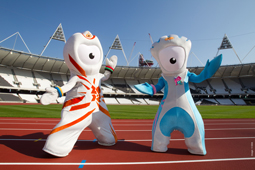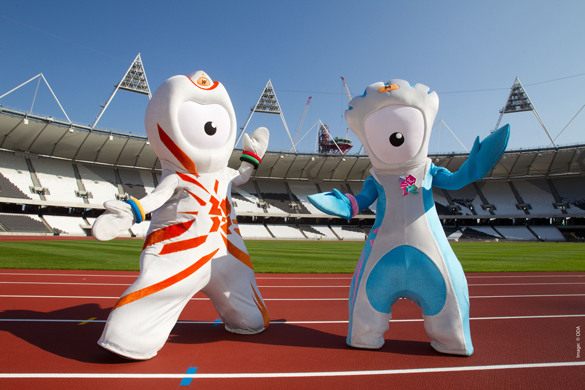From a queen’s demand that forever changed the marathon, to the relocation of 2,000 east London newts, BRITAIN brings you some intriguing facts about London’s past and present Olympic Games
WORDS Julia McDonald
1 What’s in a name?
Wenlock and Mandeville are the official mascots of London 2012. They serve as reminders of two momentous milestones in British Olympic and Paralympic history. Wenlock’s name is inspired by the village of Much Wenlock in Shropshire, where Baron Pierre de Coubertin was inspired to create the Modern Olympic Games. Mandeville, the Paralympic mascot, pays tribute to Stoke Mandeville where, in 1948, a sporting competition for injured World War II veterans was held on the same day as the Opening Ceremony of the London 1948 Olympics and formed the basis of today’s Paralympic Games.
2 Third time’s a charm
London on 27 July 2012, will be the first city to host a third Summer Olympic Games. King Edward VII officially opened the Games at White City Stadium in 1908 and King George V did the honours at Wembley Stadium in 1948. This year Queen Elizabeth II welcomes the world at the Opening Ceremony in the Olympic Stadium in Stratford.
3 Unlucky for Rome
The 1908 Olympics were very nearly not held in London. The Games were originally planned for Rome, but the eruption of Mount Vesuvius in 1906 caused the city to step down as host, after which London was chosen as the replacement. Quite conveniently, the Franco-British Exhibition was already planned for the summer of 1908 in London, and the organisers were persuaded to accommodate a cycle track, swimming pool and athletics track in what became White City Stadium. The swimming pool was built on the infield of the athletics track, which was in turn built within the cycle track, and the competition was held outdoors.
4 Keep on running
If you’ve ever wondered why a marathon covers the rather unusual distance of 26 miles and 385 yards, it’s the 1908 Olympics we have to thank. Up to this point in time, the standard marathon length was a very practical 25 miles; however, Queen Alexandra requested an extra mile-and-a-bit be added so that the start could be enjoyed by the king’s grandchildren on the lawns of Windsor, with the finish directly under the Royal Box at White City Stadium.
5 A lot of balls
Considering the scale of the Olympics, it’s perhaps not altogether unexpected to learn that an incredible amount of equipment will need to be sourced. That said, you might be surprised to find that more than one million pieces of equipment will be required, including over 2,200 tennis balls, 2,700 footballs, 6,000 archery target faces and 270,000 clay targets for the shooting events.
6 Float like a butterfly
The London 2012 Olympics will be the first to see women’s boxing. The sport is still dominated by the men’s events, with 250 male competitors to 36 female, but it’s a huge step forward.
7 Sporting new threads
In 1948, post-war measures still had a huge impact on everyday British life. However, if you were fortunate enough to make the British Olympic team, these hardships were somewhat lessened. Along with extra food rations, one particular perk for athletes was the Olympic uniform. At a time when citizens were limited to a single new shirt or blouse every 20 months, the uniform was an effective wardrobe jackpot.
8 Sight to behold
While London’s Olympic Park will be the hub of activity, other events are planned for some of the city’s most historic settings. Both the triathlon and marathon swimming will take place in Hyde Park’s Serpentine, the cycling time trials will begin and end at Hampton Court Palace, and the beach volleyball matches will have the iconic Horse Guards Parade for a backdrop.
9 Need for speed
As the opening ceremony began for the 1948 London Games, the British team realised the team flag had been left in a distant car park. A young medical student was despatched to fetch it. Fortunately the young man could run. His name was Roger Bannister and within six years he would run the mile in less than four minutes.
10 What about the newts?
The creation of the Olympic Park has produced an incredible 250 acres of parkland in east London. Prompting the largest planting project the UK has ever seen, the parkland is now home to over 4,000 new trees and 350,000 new wetlands plants. The project also required the happy relocation of 2,000 newts to a nature reserve.







 © 2024
© 2024